
Growing for good: Organic farming in Lakewood, Pa.
| September 11, 2023
Two Creeks Farm is a 100-acre organic regenerative farm in the hills of northeast Pennsylvania where the cattle and the sheep and the hogs and the chickens and the turkeys and the trees and the water and the vegetables and the bees all support each other.
Stories by Delaware Currents usually focus on water: How much is there and is it clean?
But what happens on the land makes its way into the water supply — whether it’s broken stream banks that degrade, allowing more silt into the water; or the various chemicals that “regular” farming uses; or the fire-retardant foam used on military bases that gave us the now-ubiquitous PFAS/PFOS.
Organic farming seeks to minimize the land’s effect on water, as well as aiming to minimize the more or less toxic chemicals that we ingest.
The method used here is based on one developed by Allan Savory, a Zimbabwean livestock farmer and president and co-founder of the Savory Institute.
He originated what is called holistic management — a systems approach to managing resources. His emphasis was on the beneficial impact that the proper grazing of cattle can have on the environment.
Here, the bees and the vegetables are among the few denizens that aren’t moved to new grazing land almost every day. Though the bees, of course, move themselves — up to a mile away. On a recent tour hosted by the farm, they did look — from a safe distance — busy as, well, bees. The vegetable garden is not far away, as is the pond.
Figuring it all out is the farmer, Brent Habig, who’s been involved in organic farming for decades and who came to Lakewood, Pa., to farm about three years ago.

Habig, an official trainer with Savory, was based in New York City since 2000, but worked internationally in large agricultural projects in Africa and Asia. He left Shanghai just before Covid and started farming here.
When asked about the widespread colony collapse — clearly not a problem here — he reasoned that there are only summer camps nearby, so there’s little likelihood of cross-contamination. Everything on the farm is certified organic except the honey, which demands an even higher level of scrutiny for the suspected culprit behind the collapse, the varroa mite.
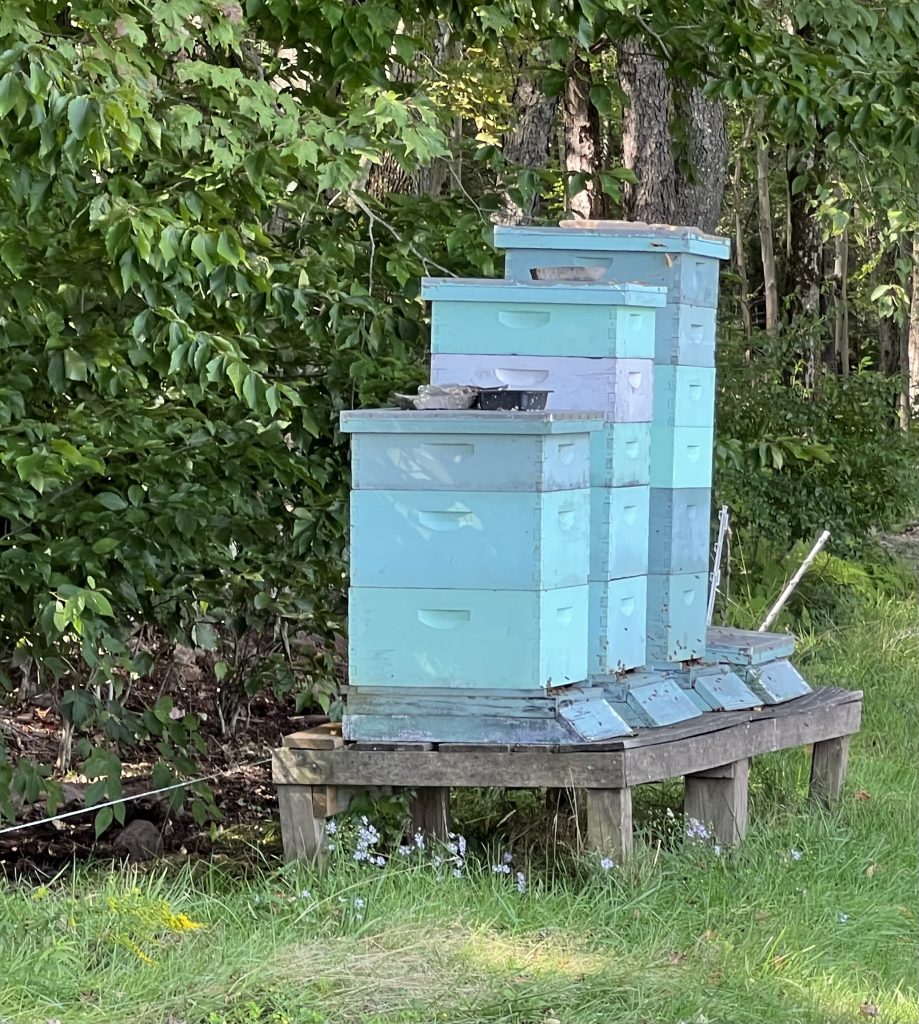
Right next door to the bees are two expectant hogs: Christmas, is a gilt — a young female that has never had piglets. The other, Snickers, has farrowed, and is called a sow. (These two are called hogs because they are large — over 250 pounds. When they were younger and smaller, they were called pigs.
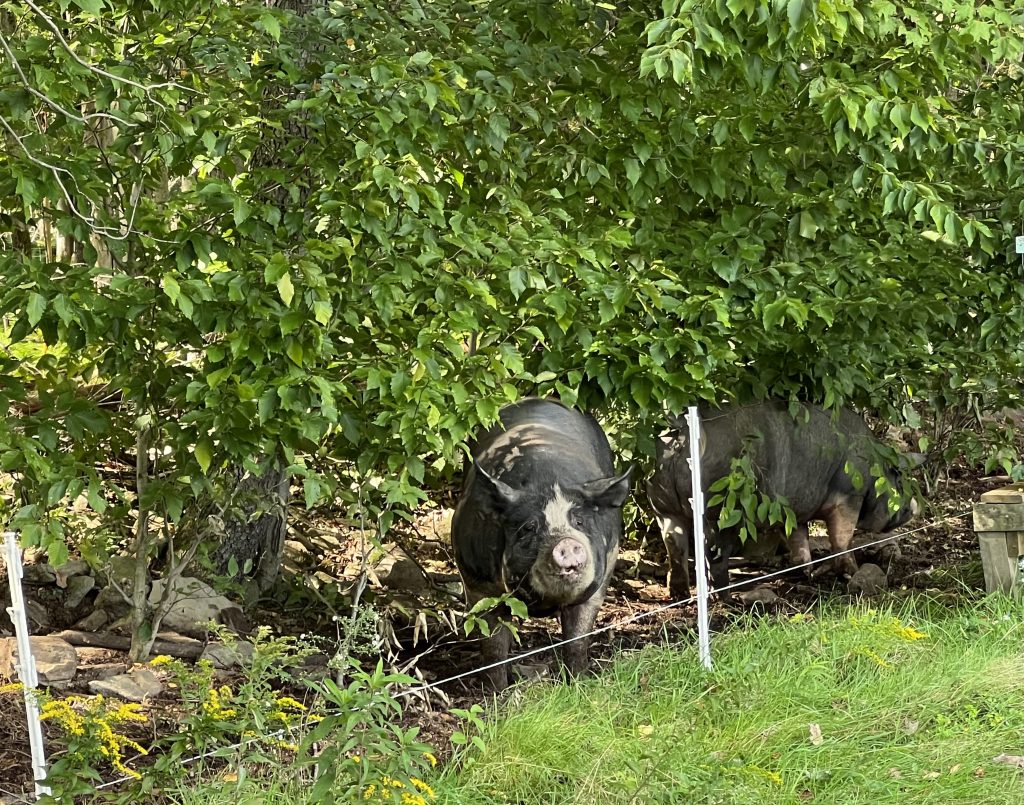
Snickers is doing what hogs will do, if left to their own devices: rooting around to find whatever there is to munch on. Christmas, due to sow sooner, is laying low in the shade. Habig explains that hogs have no natural cooling system — no sweating or panting. Lying on the ground in the shade is the best defense against heat.
They are working for the farm, turning a mature forest into a less-mature forest, one that will eventually allow other animals to graze and support a healthy tree population.
In the vegetable garden, we could see a number of different growing avenues: peppers were under partial shade in a plastic greenhouse with its sides open to the sun. There were raised beds and short rows of rotating veggies. Composted manure is spread as a fertilizer.
This is a no-till garden, which preserves the structure of the soil and the various good bugs that help. Farm workers lay about an eight-to-nine-inch layer of compost to start and add some as the year progresses.

That compost must be pretty powerful. Have a look at the tomato plants, taller than Habig and the CBD hemp, looking lush.
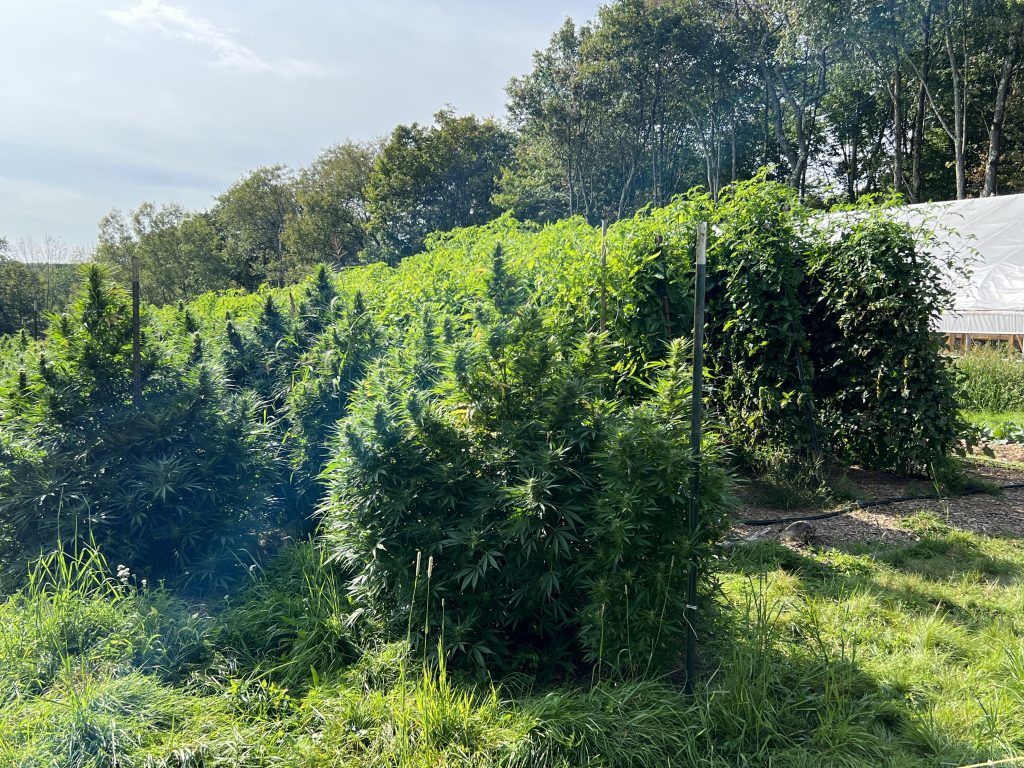
The CBD hemp plants are strictly controlled, with testing that allows for only a small amount of THC — Tetrahydrocannabinol — which is the psychoactive drug. If a greater than that small percentage is found in a plant, all the plants are burned.
Trees are an important part of this method of regenerative farming. The 100 acres is in a hilly part of Wayne County, and in order to balance the groundwater supply, the line of trees follows the slope of the hillside. That way, the trees help the ground absorb rain water instead of that water just rushing down the hillside.
“The goal is to move the water as slowly as possible,” Habig said.
Those parallel lines of trees will allow animals to graze in the alley between the trees, and the animals will fertilize the soil.
There are hoses everywhere, since all the animals need water and the movable basis of this style of husbandry demands that there is always water available wherever the animals are. The farm has recently dug a pond to supply water if there’s a drought and to further replenish groundwater.
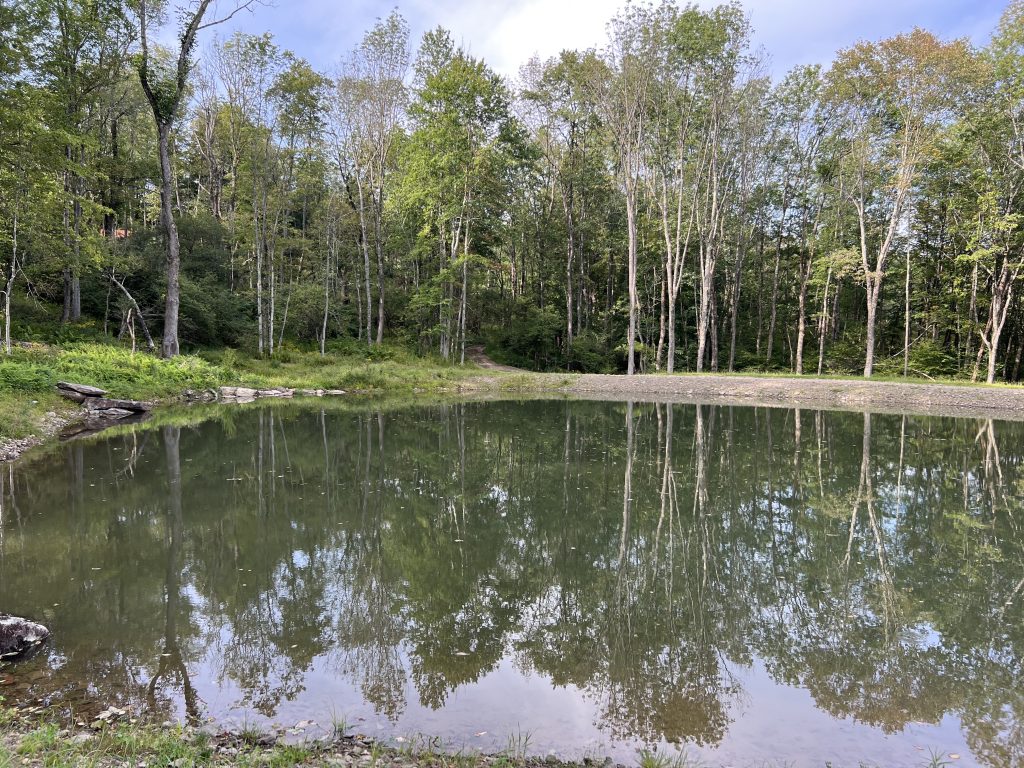
Another big field houses chickens in all stages of growth. There are 60 broilers in a cage that allows them to run around and dig in the earth — and fight with each other. The cage protects them from predatory owl attacks. That’s not the case with the fully grown chickens (20 different breeds) that an owl wouldn’t even attempt to attack.

The chickens, too, like to fight and no one interferes with that. They live inside an electric fence and have automated nest boxes. The nest box structure and the electric fence gets moved regularly to allow the chickens to dig in the soil.
Two Creeks has about 600 poultry: the broilers, the laying chickens and younger chickens in a nearby enclosure that will replace the laying hens when they no longer produce eggs. The chickens produce about 20 dozen eggs a day. Some of the breeds here produce colored eggs with tinges of blue or green.
The other poultry on the farm are turkeys. But these are separated from the chickens to prevent the spread of disease. They, too, have a movable enclosure. Habig said that these are not really wild turkeys, though they are a far cry from domesticated ones.
“They have access to natural forage, sunlight and fresh air,” he said.
All the turkeys are killed and sold in October.
It’s not just the farm animals who can spend time here. There’s a tiny house on the farm, which can house two people. The couple who stayed there the previous night were on the tour, and Habig said you can find it on Airbnb. The couple didn’t look the worse for wear.

The last stop on the tour is the field where the Highland cattle and the sheep are grazing.
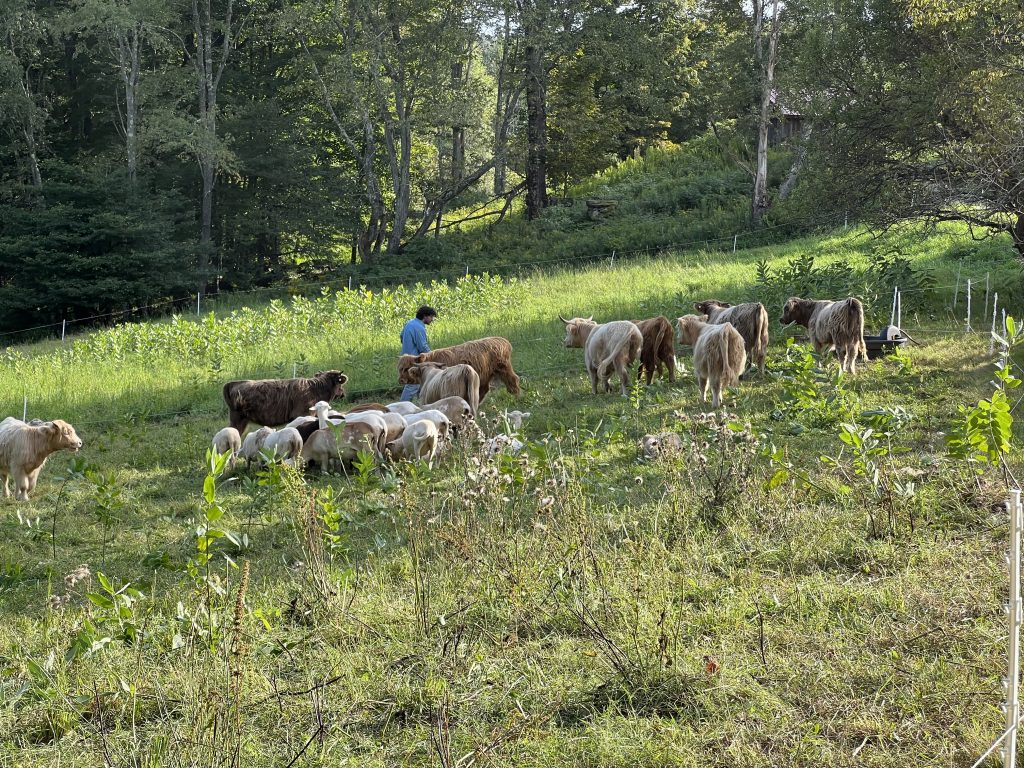
Though there are dogs on the farm, they know enough to keep clear of the cattle, which would not welcome them. The cattle, raised for beef, protect the sheep and both are for breeding.
Habig explained that they keep available a buffet of minerals for the cattle to have whatever they need. He knows, for example that the ground is selenium deficient.
“They eat an enormous amount of selenium,” he said. There’s no testing, just trusting that the animals know what they need.
Farm workers prepare the livestock for the move to a nearby section, and, perhaps knowing that good forage is ahead, there’s a considerable hustle in the livestock to get there. And much happy munching once they’ve arrived.
Each field will have four or five turns being the area where the livestock are settled for a day or so.
While on line, one of the guests, Ann Jones, stopped me to tell me how much transitioning to organic food has meant to her and her family, especially to her middle son, Tristan, who is now six and autistic.
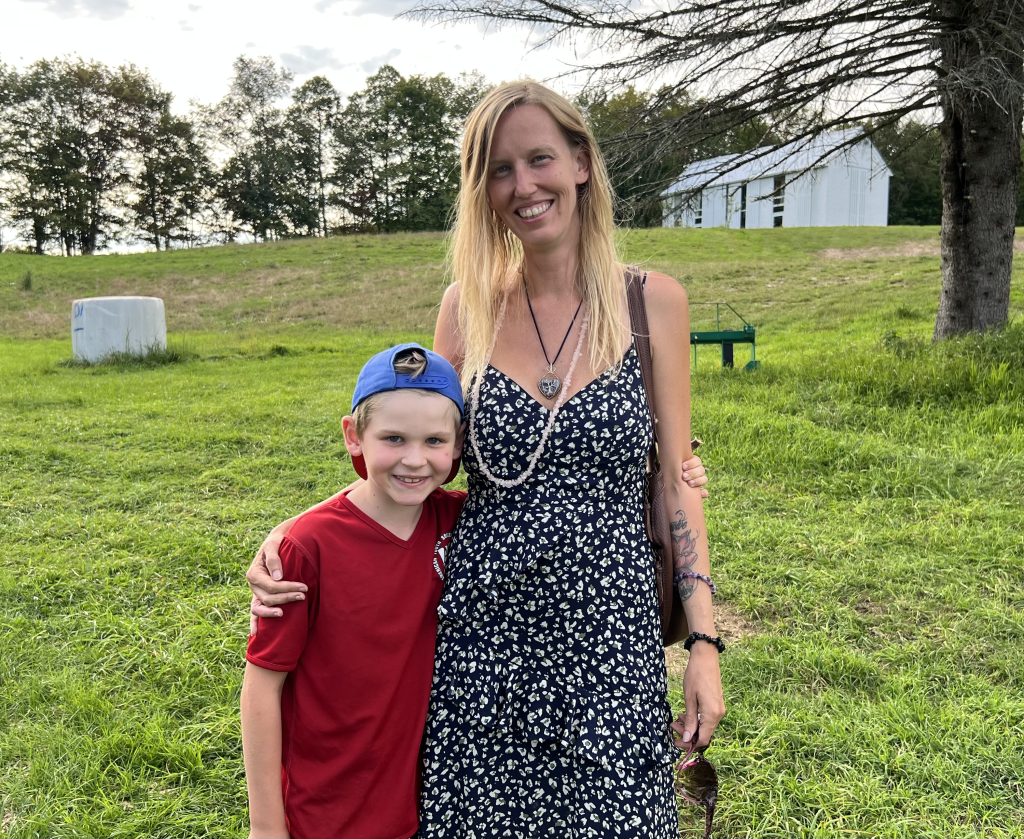
They changed their diets in 2020, but before that Tristan was exhibiting symptoms of autism: emotional outbursts, no type of verbal communication, no eye contact.
“He was lost in his own world,” Jones said. “I was giving him eggs and toast and chocolate milk for breakfast. All his symptoms were a reaction to the food he was eating.”
Within 48 hours, his symptoms were diminishing. “The cleaner we got, the more the symptoms went away. Eye contact returned and he was even singing,” she said.
Money raised from farm tour tickets goes to the Farm Arts Collective a combination theater group and organic farm in Damascus, Pa., run by Tannis Kowalchuk,

If you’d like to buy some Two Creeks products, they are at farmers’ markets in Narrowsburg, N.Y.; Hackettstown, N.J.; and Honesdale, Pa.; and other locations listed on its website: https://www.twocreek.net/






